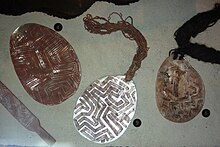Riji
Riji are mother-of-pearl bowls traditionally worn by male Aborigines in north-western Australia, in the area of today's Broome . The word Riji comes from the Bardi language and is sometimes called jakuli .
use
Rijis are worn similar to leather aprons to cover the pubic area. They are tied to a belt with a ribbon of fibers and tied around the waist with a ribbon. Traditionally, only men initiated at the highest level could wear the riji.
Often rijis are carved with sacred designs that are either the tribe's insignia, tell stories, or have some other meaning. Rijis are associated with water, spiritual power and healing because of their glowing and shimmering surface. Bardi compare the light reflected from the bowls to lightning flashes of the rainy season and to light reflected from the cheeks of the rainbow snake , which is closely associated with water and rain.
One of the unique patterns used in the Kimberleys is a nested pattern. The incised patterns are rubbed into the grooves with a mix of ocher and resin from the spinifex grass, thereby highlighting them. Decorated and bare mother-of-pearl bowls are used for making rain and other magical purposes.
Riji were very valuable objects and were traded inland over long distances. They have been found at Yuendumu in the desert, south-eastern Arnhem Land , Queensland, and South Australia . Often the bowls were decorated along the trade route, that is, far away from the place of origin.
Artists still produce rijis today, which can be seen in Broome. Some use older, sacred patterns while others choose more modern designs.
See also
Web links
Individual evidence
- ↑ Short St Gallery ( Memento of the original from September 27, 2007 in the Internet Archive ) Info: The archive link was inserted automatically and has not yet been checked. Please check the original and archive link according to the instructions and then remove this notice.
